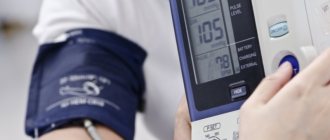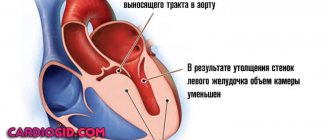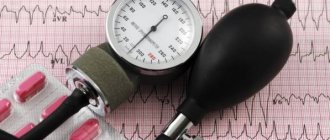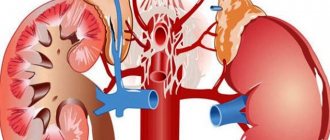Who to contact first
VSD is a disease that does not have a place in the WHO worldwide classification, however, the pathologies inherent in dystonia belong to groups of diseases according to ICD 10.
A person who has health problems that resemble dystonia in their symptoms should seek the help of a therapist. It is this doctor who assesses the general condition of the patient and refers him to specialized specialists.
It is necessary to pay attention to the fact that the symptoms of vegetative-vascular dystonia may actually be signs of other, no less serious diseases of the cardiovascular, endocrine or respiratory systems.
Therefore, timely, competent diagnosis is so important, allowing a correct diagnosis to be made and therapy to be started immediately.
Click to enlarge
How to treat VSD: reasons, which doctor to contact, treatment
Vegetative-vascular dystonia is established in almost every 4 patients. The disease manifests itself with a whole range of symptoms that often cause panic in a person. There are currently no drugs that relieve unpleasant symptoms. Treatment of VSD is carried out using several methods at once.
Causes of VSD
The exact reasons why vegetative-vascular dystonia occurs have not been identified. But, thanks to many studies conducted, a number of provoking and fundamental factors have been identified:
- Pathologies of the endocrine system. Symptoms of the disease often appear in patients with previously diagnosed hypothyroidism, hyperthyroidism, and diabetes mellitus.
- Genetic predisposition. Most of the patients had close relatives who suffered from VSD.
- Stressful situations. Disruption of the nervous system leads to changes in the functioning of the heart muscle, which provokes the appearance of the clinical picture.
- Brain lesions. These include traumatic brain injuries of varying degrees, malignant and benign neoplasms, and strokes.
Signs of dystonia are found in people who lead a sedentary lifestyle, abuse alcohol, and smokers.
The clinical picture of VSD is varied. But many patients complain of a feeling of anxiety for no apparent reason, the appearance of asthenic syndrome.
There is also disruption of the digestive tract and increased sweating. At the same time, cold sweat appears. There is numbness in the arms and legs and decreased performance.
Useful information But the most important sign of VSD is headache, which most often appears with dizziness. It can go away after a few minutes, hours or days, depending on the severity of the attack.
Experts have found that such symptoms arise as a result of disruption of the cerebral cortex, hypothalamus and endocrine system.
Unpleasant signs of VSD quite often occur in school-age children, which is explained by hormonal changes in the body and a heavy load on the nervous system.
What is special about the diagnosis?
VSD, unlike many similar pathologies, has its own characteristics. First of all, the disease can manifest itself in both children and adults.
Attacks vary in severity and often patients experience more psychologically than physically. This is due to the appearance of panic attacks during attacks, when the symptoms are pronounced and feelings of fear arise. This condition is very dangerous, since at the moment of dizziness a person can fall and injure himself.
The disease disrupts the patient’s usual rhythm of life and makes one suspect the presence of serious health problems.
Also, the peculiarities of VSD include the suddenness of attacks. They appear regardless of what a person does.
A panic attack can occur in a public place, while driving, at work or school.
As a result, many people become afraid to leave the house, a person limits communication with friends and relatives, and begins to withdraw into himself. VSD often requires the help of a psychologist.
Which doctor should I contact for VSD?
If symptoms such as dizziness, increased sweating, headaches and others appear, you should consult a therapist or neurologist.
In cases where there is a disruption in the functioning of the cardiovascular system, a cardiologist treats the pathology. VSD often manifests itself in the gastrointestinal tract. In this case, pain or cramping occurs in the abdomen. In this case, treatment is carried out under the supervision of a gastroenterologist.
But most often, to clarify the preliminary diagnosis, the therapist prescribes a consultation with several specialists at once. This allows you to develop the right treatment tactics and avoid serious consequences.
Treatment of VSD
Only a doctor can tell you how to treat VSD. But to relieve symptoms and reduce the number of attacks, complex therapy is used, which includes not only medication, but also psychotherapy, a special diet and other methods.
Lifestyle
When vegetative-vascular dystonia occurs, it is important first of all to change your lifestyle, since it is the fundamental factor in the manifestation of the clinical picture.
Experts have found that in most cases it is possible to get rid of the manifestations of the disease only by maintaining a correct lifestyle. Doctors recommend adhering to the following rules:
- Develop a daily routine and strictly follow it. You need to go to bed no later than 11 pm. It is especially important to eat at the same time every day. Thus, after some time the body will follow the biological clock and work without failures. You should not fast for a long time.
- Get enough sleep. The duration of sleep for an adult should be no more than 8, but not less than 7 hours. At the same time, before going to bed, it is important not to overstrain your brain and vision. For an hour and a half, you don’t need to watch TV or use tablets or phones. It is recommended to listen to calm music and read a book in good lighting. You should also not eat food before bed, especially with VSD.
- Get out into the fresh air regularly. Daily walks help saturate the body with oxygen and improve blood circulation. Hiking, therefore, allows you to keep your body and spirit in good shape. Don't forget to dress for the weather.
- Avoid stressful situations. You don't need to take anti-anxiety pills to reduce stress. It is enough to drink chamomile or mint tea regularly. They will restore the functioning of the nervous system and will not have a negative effect on the body.
Experts recommend playing sports. This could be swimming, running, roller skating, skiing or skating. Exercise is important, especially for people who lead a predominantly sedentary lifestyle.
Medicines
Many patients, faced with the problem of dystonia, are interested in whether VSD can be cured.
The disease is treatable, but most often with difficulty. In severe cases, medications of various groups are used:
- Sedatives. Products with a slight calming effect. These include infusions of valerian and motherwort.
- Tranquilizers. Drugs with a stronger sedative effect. Prescribed by a doctor and available with a prescription.
- Antidepressants. Medicines have a strong calming effect. But they are used only in the most severe cases, as they can be addictive.
- Adaptogens. Products whose active substances increase the body’s resistance to various psycho-emotional influences. There are drugs of natural origin and synthetic analogues.
- Nootropic. They can significantly improve the process of saturating the brain with oxygen and nutrients.
Multivitamin complexes and agents that improve blood circulation in the brain are also used. All medications should be prescribed only by your doctor, as many of them can be addictive or cause side effects.
Psychotherapy
When establishing VSD, a therapist or neurologist refers the patient to a psychiatrist or psychotherapist, depending on the severity of the pathology.
A specialist often prescribes breathing exercises for dystonia. A contrast shower has a special calming effect. In addition, it also helps strengthen the walls of blood vessels and maintain their tone.
Certain techniques of psychological influence are also used for VSD. These include:
- Psychoanalysis. The doctor finds out the cause of the disturbance in the patient’s psycho-emotional state, helps to understand it and, using suggestion or other methods, eliminate it.
- Behavioral therapy. This method is used to find out the reasons and change the patient’s attitude towards them.
- Gestalt treatment. The doctor, together with the patient, divides all events into major and minor ones. In this case, situations that caused a violation of the psycho-emotional state are classified as secondary.
Hypnosis is used if necessary. The patient is put into a light trance and suggested that the problem that has arisen is not the main one in life.
The method of therapy for VSD is selected by a psychologist or psychoanalyst depending on the characteristics of the course of the pathology, the causes of its occurrence and the severity of the course.
Diet
There are several reasons for the occurrence of vegetative-vascular dystonia. Among them are disturbances in vascular tone and blood circulation in the brain. Useful information A similar condition can appear as a result of poor nutrition, when there are not enough vitamins and microelements. That is why patients with VSD are prescribed a special diet. It requires compliance with the following rules:
- Increase the amount of vegetables and fruits.
- In the absence of an allergic reaction and with good tolerance, introduce dairy products into the diet.
- Eat lean meat and fish.
- Avoid sweets. It can be replaced with honey, dried fruits and nuts.
- Avoid drinking strong tea and coffee.
The use of spices is not recommended. You should give up alcoholic beverages and smoking. You should eat at the same time in small portions up to 5 times a day. It is important not to starve, but also not to overeat.
Physiotherapy
For VSD, massage, exercise therapy, electrophoresis, magnetotherapy and other physiotherapeutic methods are used.
They are aimed at improving blood circulation, relieving unpleasant symptoms and reducing stress. But before prescribing treatment, the doctor must make sure there are no contraindications.
Folk remedies
For mild to moderate dystonia, traditional medicine can also be used. Melissa, chamomile, hawthorn and motherwort have a beneficial effect on the body.
They help to calm down and bring the psycho-emotional state back to normal. Herbs are brewed both individually and as a collection. Take 100 ml for VSD three hours before meals. Traditional medicine recipes should be used after consultation with a specialist.
Vegetative-vascular dystonia is one of the most common diseases. It requires an integrated approach to treatment. Methods are prescribed by a doctor on an individual basis depending on many factors. Only a specialist can answer the question of how to cure VSD.
Source: https://nervy-expert.ru/vsd/kak-lechit-vsd/
Complex treatment
The presence of autonomic disorders in the body is a complex of symptoms that need to be treated simultaneously, so it is important to pay attention to the symptoms.
Comprehensive treatment of VSD includes contacting the following specialists:
- a psychotherapist or psychologist (going for help to a psychological consultation for VSD can solve problems without prescribing additional examinations);
- neurologist;
- cardiologist;
- urologist;
- pulmonologist;
- gastroenterologist;
- endocrinologist.
Each specialist is responsible for the health of certain organs and systems of the human body. By ordering other examinations, a specialized doctor will determine the presence or absence of signs of disease, according to his specialization. He will select appropriate treatment methods or refer you for additional examination necessary for the treatment of VSD.
Treatment of VSD
You need to exercise, but in moderation, without overdoing it.
Having figured out which doctor treats VSD and panic attacks, you should dwell in more detail on the treatment methods. These include:
- taking tranquilizers, nootropics, sedatives - to reduce the load on the nervous system, combat neurosis and anxiety;
- B vitamins - to restore nervous activity and strengthen the nervous system;
- physiotherapy, massage - for relaxation and stress management.
The main methods of treatment are a daily routine, normal rest, proper nutrition and moderate but regular physical activity.
Gastroenterologist
This specialist deals with problems of the gastrointestinal tract. You should consult him if you have the following symptoms:
- nausea;
- occasionally recurring vomiting;
- digestive disorders;
- flatulence;
- pain in the epigastric region.
Such manifestations can be associated both with digestive pathologies and with the influence of stressful situations, fear or tension, physical or mental.
A gastroenterologist can diagnose VSD; for this he conducts the following studies:
- examining the patient, palpating, tapping and listening to internal organs;
- taking samples for laboratory research (biological secretions and fluids);
- ultrasonography;
- computed and magnetic resonance imaging;
- radiography;
- endoscopic examination;
- biopsy.
It is impossible to contain exacerbations of dystonia without resorting to proper nutrition. The gastroenterologist will create a diet based on the individual characteristics of the patient’s body.
When should you go to the doctor?
Vegetovascular dystonia occurs in many people. Symptoms of pathology are different. But in all cases, they cause a lot of inconvenience to a person and worsen the quality of life.
When the first signs of pathology appear and to exclude other, more serious diseases, you need to consult a doctor. Common signs of disorders of systems and organs during VSD are presented in the table:
| Body system | Symptoms |
| Cardiovascular | Pain near the heart |
| Tachycardia | |
| Blood pressure surges | |
| Arrhythmia | |
| Central nervous | Weakness |
| Irritability | |
| Headache | |
| Panic attacks | |
| Deterioration of sleep | |
| Neurosis | |
| Respiratory | Difficulty breathing |
| Heaviness in the chest | |
| Lack of air | |
| Dyspnea | |
| Thermoregulation system | Change in body temperature |
| Digestive | Abdominal pain |
| Nausea | |
| Disorder | |
| Belching | |
| Vomit | |
| Genitourinary | Frequent, painful urination |
To make a diagnosis, a comprehensive examination by doctors is required.
If you have such symptoms, you should consult a doctor. It is advisable to do this as early as possible to avoid the development of serious diseases. To clarify the diagnosis, a diagnosis and examination should be carried out by different specialized doctors. To determine whether a patient has hidden pathological conditions, he should be examined by as many doctors as possible.
Cardiologist
You should see a cardiologist if you have the following symptoms:
- heart rhythm disturbances, characterized by its acceleration, deceleration or unevenness;
- chest pain of varying degrees of intensity;
- difficulty breathing;
- feeling of suffocation;
- feeling of heaviness in the chest;
- pain in the left side of the body;
- changes in blood pressure.
You should visit a cardiologist before going to a neurologist. This specialist can distinguish between signs of diseases of the cardiovascular and autonomic systems.
To make a diagnosis, the cardiologist prescribes the following studies:
- electrocardiogram (both at rest and during exercise);
- echocardiogram;
- daily blood pressure monitoring (using a Holter monitor);
- CT scan;
- Magnetic resonance imaging;
- radiography;
- scintigraphy.
To stabilize the patient’s condition, the cardiologist prescribes medications that have vasodilating properties, strengthen the heart muscle, normalize blood pressure and bring the heart rate back to normal.
Initial appointment
VSD is manifested by changes in the functioning of the heart and blood vessels, respiratory and digestive systems. It can be difficult for a person to independently determine which doctor to see. The right decision in this case would be to make an appointment with a local therapist.
After the patient voices complaints and describes how he felt at the time of the attack, the doctor usually carries out most of the actions described below:
- measurement of blood pressure and temperature;
- counting pulse and heart rate (HR);
- assessment of the condition of the skin.
To collect anamnesis, the doctor needs to find out:
- what chronic diseases does the patient suffer from?
- whether there is a diagnosis of VSD in close relatives;
- Do you have panic attacks?
- what medications the patient is taking;
- what factors increase the symptoms of dystonia;
- what ways help normalize well-being.
Next, consultations with narrow specialists are scheduled, if necessary.
Which doctor the therapist recommends to visit for further examination depends on the symptoms that most bother the patient. VSD can occur in different forms:
The cardiovascular form of dystonia is characterized by:
- periodic increase or decrease in blood pressure;
- interruptions in heart function;
- tachycardia;
- painful sensations in the chest area.
Hyperventilation dystonia is manifested by the following symptoms:
- increased breathing;
- dyspnea;
- feeling of pressure in the chest;
- discomfort when inhaling and exhaling;
- dizziness.
Irritable bowel syndrome is accompanied by the following symptoms:
- stomach ache;
- nausea;
- sensation of a lump in the throat when swallowing;
- constipation followed by diarrhea;
- decreased appetite.
In the psychoneurological form of dystonia, the following manifestations are noted:
- increased fatigue;
- weakness;
- irritability;
- recurrent headaches;
- frequent mood swings;
- sleep disturbance.
VSD is often accompanied by disorders of the genitourinary organs and manifests itself:
- frequent urination;
- sexual dysfunction;
- decreased libido.
At the time of crisis, increased sweating, panic, and darkening of the eyes may be observed.
The main treatment for a patient with manifestations of vegetative neurosis is prescribed by a neurologist or psychotherapist. But if the patient consults another doctor with symptoms that bother him, the specialist must examine him and prescribe examinations and tests. Based on the diagnostic results, treatment is selected or the patient is referred to another doctor.
Prolonged malaise, decreased performance and mood are good reasons to seek help from a general practitioner. And in the case of muscular dystonia in newborns, see a pediatrician. The sooner a full examination is carried out, the more effective the treatment will be.
Complex treatment, selected based on the results of tests and instrumental examinations, reduces the likelihood of frequent exacerbations of VSD.
Neuropathologist
A neurologist is a specialized specialist who deals with the issues of vegetative-vascular dystonia. He finds the causes and symptoms of abnormalities in the functioning of the autonomic part of the central nervous system.
The neurologist necessarily pays attention to the following symptoms:
- irritability for no reason;
- unjustified aggression;
- profuse sweating;
- anxiety;
- sleep disorders;
- loss of strength;
- headaches;
- changes in emotional background.
This specialist examines the patient to detect the following pathologies:
- osteochondrosis of the cervical or thoracic spine;
- intercostal neuralgia;
- pinched blood vessels or nerves;
- deficiency of nerve cell nutrition;
- structural abnormalities of the nervous system.
For this purpose, the neurologist uses different diagnostic methods:
- examining the patient and identifying suspicious symptoms;
- magnetic and computer tomography;
- Ultrasound examination of cerebral vessels with Doppler sonography;
- EEG;
- X-ray of the spinal column;
- electromyography.
The basis of therapy prescribed by a neurologist is the use of tranquilizers, sedatives, nootropics and other medications.
Urologist
A urologist is a doctor whose visit cannot be avoided by people diagnosed with dystonia. Sometimes a situation arises when a person’s blood pressure changes, especially its lower limit. This may be evidence of kidney disease or be a sign of VSD.
You should contact a urologist if you have the following symptoms:
- increased number of urinations;
- increased volume of urine excreted;
- pain in the lower back, in the area where the kidneys are located;
- increasing concern about the symptoms listed above.
A urologist can diagnose and exclude the following diseases: pyelonephritis, endometriosis, inflammation of the prostate gland, kidney stones and others.
To make a diagnosis, the doctor uses the following diagnostic methods:
- taking urine tests;
- performing ultrasound of the pelvic organs;
- cytoscopy;
- urography.
What is needed for the result to be positive?
Practice shows that VSD is most often diagnosed in adolescents. This is explained by hormonal changes in the body during puberty. However, symptoms of dystonia often accompany an adult. This happens more often in women than in men, due to greater emotionality, characteristics of the nervous system, and emotional overload. Advanced symptoms of VSD in adolescents threaten the development of nervous dysfunction into more serious disorders of organs and systems. As for women, their neuro-emotional state also affects the intrauterine development of the child during pregnancy. This cannot be ignored if there are signs of VSD.
Dystonia can be cured provided that medical recommendations are strictly followed, a daily routine is observed, and a healthy diet is followed. It is necessary to avoid overwork, nervous and physical strain, stress, and unnecessary worry. It is worth reconsidering your habits, getting rid of physical inactivity, the habit of “winding up” yourself, being afraid of what has not yet happened and may never happen at all. Unfortunately, many people have this bad mental habit. You need to bring more positive emotions into your life, spend more time in the fresh air, try to notice nature. And share positivity with the people you love. In the end, the VSD will simply “forget” about you and never return.
Endocrinologist
Disturbances in the functioning of the autonomic part of the central nervous system can be directly related to endocrine pathologies, therefore, if you suspect the presence of VSD, it is important to seek advice from an endocrinologist.
A specialist in this profile is contacted with the following complaints:
- feeling overwhelmed;
- sleep problems;
- change in body weight without the influence of other reasons;
- increase or decrease in usual pressure figures;
- increased sweating;
- heart rhythm disturbances;
- mood changes.
An endocrinologist, after conducting research, can make the following diagnoses: hypothyroidism, thyroiditis, diabetes mellitus, thyroid cysts and others.
endocrine system examined by an endocrinologist
To diagnose pathologies, this specialist uses the following methods:
- analysis of sugar and hormones contained in the blood;
- radiography;
- Ultrasound;
- tomography, computed tomography and magnetic resonance imaging.
If hormonal imbalances are detected, the endocrinologist prescribes drugs that solve this problem. Only after normalization of hormonal levels will the patient be able to begin treatment for the remaining symptoms of VSD.
Comprehensive examination
The disease called “vegetative-vascular dystonia” does not exist in the scientific literature. It has symptoms of other diseases. Therefore, to determine the scheme and methods of treating dystonia, it is necessary to conduct a comprehensive examination by several specialists, depending on the patient’s complaints.
In addition, a comprehensive examination allows you to determine the nature of dystonia. VSD is classified into hypotonic and hypertensive types, cardiac and mixed types. For each type of VSD, its own treatment methods are selected.
The difficulty of making a diagnosis is due to the fact that the signs characteristic of dystonia are also inherent in many pathologies of internal organs. Therefore, during the examination, it is first necessary to exclude the presence of other diseases.
Based on the test results, the specialist prescribes appropriate therapy. It is a comprehensive treatment for VSD - in addition to medications that eliminate the main symptoms, the patient is prescribed, for example, treatment by a neurologist and psychotherapist and giving up bad habits, diet, physical activity and healthy sleep. This will cure VSD and the panic attacks that accompany it.
Neuropathologist - specialized specialist
A neurologist is a specialist who treats diseases of the human nervous system. Since VSD is considered a dysfunction of the nervous system, it is most logical to first contact a neurologist.
Patients with dystonia turn to a neurologist with the following symptoms:
- strong feelings of anxiety and restlessness;
- frequent aggressiveness and irritability;
- constant fatigue;
- insomnia;
- mood swings;
- increased sweating, etc.
First, the neurologist diagnoses the patient’s condition to identify other neurological diseases, such as osteochondrosis, intercostal neuralgia, etc. If, after research, the doctor diagnoses vegetative-vascular dystonia, then medications such as tranquilizers, antidepressants and sedatives are prescribed. Physiotherapy, massage and sessions with a psychotherapist are widely used in treatment.
Endocrinologist
An endocrinologist is also a specialist involved in the treatment of VSD. The therapist refers the patient for further examination to an endocrinologist for patients with the following symptoms:
- the presence of primary sexual characteristics inherent in the opposite sex;
- itching;
- jumps in body temperature;
- heavy sweating;
- weight fluctuations;
- constant feeling of fatigue, etc.
These symptoms are also inherent in a number of diseases of the endocrine system, so an examination is required to identify pathologies.
Treatment of VSD and endocrine diseases is different. Many diseases of the endocrine system are dangerous to human health, so examination by an endocrinologist must be accompanied by an accurate diagnosis.
Cardiologist
When diagnosing and treating dystonia, the most important thing is to be examined by a cardiologist. Many patients with suspected VSD complain of the following symptoms:
- blood pressure surges;
- heart rhythm disturbance;
- pain in the heart area;
- difficulty breathing, shortness of breath;
- feeling of heaviness and squeezing in the chest, etc.
The cardiologist will refer the patient for examination (ECG, ultrasound of the heart, tonometry, etc.), since the symptoms of VSD are similar to the signs of pathologies of the cardiovascular system.
Gastroenterologist
With vegetative-vascular dystonia, symptoms associated with impaired functioning of the digestive system are common. Patients with suspected VSD complain of diarrhea, constipation, flatulence, abdominal pain, nausea and vomiting.
In people suffering from dystonia, the manifestation of these symptoms is not associated with gastrointestinal pathologies. These complaints are a consequence of stressful situations, nervous tension, etc. A common phenomenon with VSD is irritable bowel syndrome, accompanied by a frequent urge to defecate, but these urges are false.
Urologist
When diagnosing vegetative-vascular dystonia, a urologist is contacted with symptoms of frequent urination, lower back pain, a feeling of incomplete emptying of the bladder, the urge to urinate at night, discomfort in the kidney area, etc. The patient is prescribed a general urine test, ultrasound of the bladder and kidneys, urography, etc. .P.
If during the study no pathologies of the urinary system are found, then treatment is reduced to general therapy for VSD.
Features of choosing a doctor depending on age and gender
Vegetative-vascular dystonia may have differences in the nature and intensity of symptoms depending on the gender of the patient. Thus, in addition to the general manifestations observed in representatives of both sexes, there are signs of VSD in men, such as decreased potency, more prolonged depression and panic attacks, obsessive suicidal thoughts, etc.
The age and gender of the patient with dystonia determine the choice of the doctor to whom to contact for examination. For example, with complaints regarding the reproductive system, women turn to a gynecologist, men - to an andrologist. Primary diagnosis in children is carried out by a pediatrician in a children's clinic, and in adults - by a therapist.
The choice of treatment methods for VSD is based not only on the symptoms of the disease, but also on the overall clinical picture. Age and the presence of chronic diseases play a role in determining the treatment regimen.
Specifics
The doctor who has diagnosed VSD in the patient prescribes a set of therapeutic measures that must be followed consistently in order to achieve the disappearance of the disturbing symptoms.
The treatment process consists of the following stages:
- Eliminate all bad habits from your own life.
- Bringing the psychological mood back to normal.
- Relieving causes of stress or anxiety.
- Organizing conditions for proper rest, especially at night.
- Incorporating physical exercise into your schedule.
Only after all stages of this process have been implemented in life can drug therapy begin. As a rule, the specificity of the treatment of VSD lies in the primary elimination of the symptom that caused the development of vegetative-vascular dystonia.
Traditional medicine (in consultation with your doctor) can be combined with traditional recipes and physiotherapy. This way the improvement will come faster.











